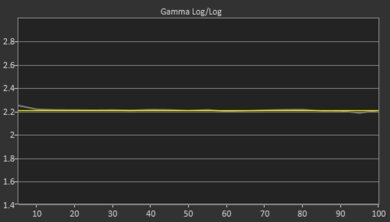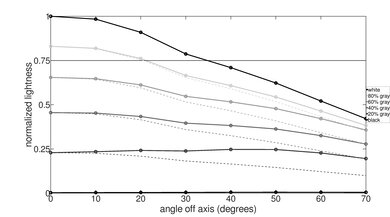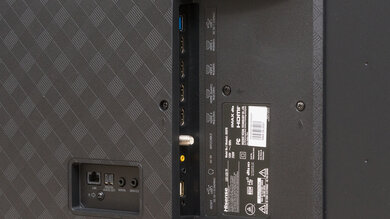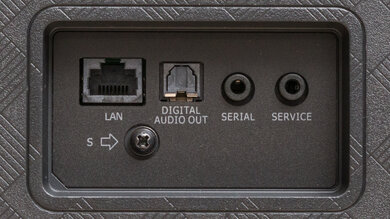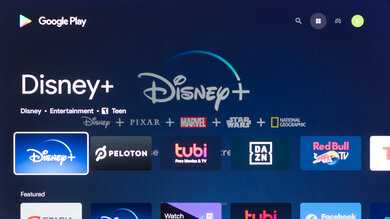The Hisense U7G is a mid-range 4k TV in Hisense's 2021 lineup, sitting below the Hisense U8G and above the simpler Hisense U6G. It offers an impressive array of additional features, including HDMI 2.1 bandwidth, which allows for 4k @ 120Hz gaming on the PS5 and Xbox Series X, and FreeSync variable refresh rate support to reduce screen tearing. It runs the Android TV smart interface, which has a great selection of additional streaming apps, so you're sure to find your favorite content. It's available in 55, 65, and 75-inch sizes, but the 75-inch version performs a bit differently, as it uses a different type of panel. It's been replaced by the Hisense U7H in 2022, but the differences between them are minor.
Our Verdict
The Hisense U7G is a great TV for most uses. It looks good in bright rooms, with high peak brightness and decent reflection handling to overcome glare. It also looks good in a dark room thanks to its decent local dimming feature and high contrast ratio, resulting in deep, uniform blacks. It's great for gaming or use as a PC monitor, with low input lag, some advanced gaming features, and a good response time. On the other hand, it's not as good for a wide seating area or for watching sports with a large group of friends, as the image degrades at an angle.
- Outstanding contrast.
- Amazing peak brightness in SDR.
- Decent reflection handling.
- Image degrades when viewed at an angle.
The Hisense U7G is a very good TV for watching TV shows in a bright room. It has amazing peak brightness in SDR and decent reflection handling, so glare isn't an issue in a bright room. Low-resolution content is upscaled well, great for watching older shows on DVD, and the smart interface has a large selection of streaming apps, so you're sure to find your favorite shows. On the other hand, the image degrades when viewed at an angle, so it's not the best if you like to move around with a show playing, or if you have a wide seating arrangement.
- Amazing peak brightness in SDR.
- Low-resolution content is upscaled without any issues.
- Decent reflection handling.
- Image degrades when viewed at an angle.
The Hisense U7G is a good TV for watching sports. It has amazing peak brightness in SDR and decent reflection handling, so glare shouldn't be an issue for those Sunday afternoon games. It has a good response time, so fast-moving objects (like the players) are clear, and cable channels are upscaled well. On the other hand, the image degrades when viewed at an angle, so it's not as good for a large group of friends or if you have a wide seating area, and there are some minor uniformity issues.
- Amazing peak brightness in SDR.
- Low-resolution content is upscaled without any issues.
- Decent reflection handling.
- Image degrades when viewed at an angle.
- Some noticeable dirty screen effect.
The Hisense U7G is an impressive TV for gaming. It has outstanding low input lag for a responsive gaming experience and a good response time, so fast action scenes are clear and easy to see. It supports a few advanced gaming features, including FreeSync variable refresh rate support to reduce tearing. It also delivers a great picture when gaming, with outstanding contrast, and the local dimming feature and peak brightness aren't diminished at all when in Game Mode.
- Outstanding contrast.
- Amazing peak brightness in SDR.
- Outstanding low input lag.
- Great gaming features like FreeSync.
- G-SYNC compatible doesn't work at the moment.
- 4k @ 120Hz isn't displayed properly.
The Hisense U7G is a great TV for watching movies in HDR in a dark room. It has outstanding contrast, which is one of the most important factors in good HDR picture quality. It has good peak brightness, and small highlights stand out in HDR, and it can display a great wide color gamut. Movies are always judder-free, as this TV removes judder from all sources automatically, and it has a large selection of streaming apps. Unfortunately, there's some stutter that might bother some people, but it's not too bad and mainly noticeable in slow-panning shots.
- Outstanding contrast.
- Small highlights stand out.
- Great wide color gamut.
- Judder-free playback from any source.
- Some stutter in panning shots.
The Hisense U7G is great for gaming in HDR. It delivers a great gaming experience with low input lag and a good response time. It has a few advanced gaming features like FreeSync variable refresh rate technology (VRR) to reduce screen tearing. It also delivers a great overall HDR experience, with outstanding contrast, so blacks look black in a dark room, and a decent local dimming feature. It also has good peak brightness in HDR, so small highlights in some games stand out.
- Outstanding contrast.
- Outstanding low input lag.
- Small highlights stand out.
- Great wide color gamut.
- Great gaming features like FreeSync.
- G-SYNC compatible doesn't work at the moment.
- 4k @ 120Hz isn't displayed properly.
The Hisense U7G is a very good TV for use as a PC monitor, with some limitations. It has outstanding low input lag and a good response time, and it supports most common resolutions, like 1080p and 1440p. It has amazing peak brightness and decent reflection handling, so glare isn't an issue. Unfortunately, it uses a suboptimal BGR subpixel structure, which reduces the clarity of text, but there are workarounds for this. Also, the image degrades at an angle, so it's important not to sit too close, or the sides of the screen will appear faded and washed out.
- Amazing peak brightness in SDR.
- Outstanding low input lag.
- Decent reflection handling.
- Image degrades when viewed at an angle.
- Suboptimal BGR subpixel layout.
- Some noticeable dirty screen effect.
- 4k @ 120Hz isn't displayed properly.
Changelog
- Updated Sep 26, 2025: We uploaded the latest brightness measurements and uniformity photos for the Accelerated Longevity Test.
- Updated Jul 08, 2025: We uploaded the latest brightness measurements and uniformity photos for the Accelerated Longevity Test.
- Updated Apr 17, 2025: We uploaded the latest brightness measurements and uniformity photos for the Accelerated Longevity Test.
- Updated Feb 11, 2025: We uploaded the latest brightness measurements and uniformity photos for the Accelerated Longevity Test.
Check Price
Differences Between Sizes And Variants
We tested the 65-inch Hisense U7G (65U7G), and these results are also valid for the 55-inch (55U7G) model. The 75-inch (75U7G) model has a different pixel structure, so it performs a bit differently, with worse contrast but a wider viewing angle. In Canada, this model is known as the Hisense U78G. Unfortunately, Hisense releases different product lines in different regions, so these results aren't valid for international models, even if they have the same name. There's no equivalent model outside Canada and the U.S.
| Size | US Model | Canada Model | Local Dimming Zones |
|---|---|---|---|
| 55" | 55U7G | 55U78G | 72 |
| 65" | 65U7G | 65U78G | 90 |
| 75" | 75U7G | 75U78G | 120 |
If someone comes across a different type of panel or their Hisense U7G doesn't correspond to our review, let us know, and we'll update the review. Note that some tests like the gray uniformity may vary between individual units.
Note: Hisense previously released an international model known as the U7G Pro. It's a different TV from the one released in North America; our review isn't valid for that model, since it has a completely different panel advertised to have a higher peak brightness and a faster refresh rate.
The unit we tested was manufactured in March 2021, and you can see the label here.
Popular TV Comparisons
The Hisense U7G is an impressive mid-range TV, but there are a few glitches that will hopefully be fixed in later firmware updates. It offers impressive value, competing with some far more expensive models from competitors, like the Sony X90J.
See our recommendations for the best 4k TVs, the best 55-inch TVs, and the best 4k gaming TVs.
The Hisense U8G is better than the Hisense U7G. The U8G has better reflection handling and higher peak brightness, so it can more easily overcome glare in a bright room. The U8G also has a better local dimming feature, better black uniformity, and the unit we bought is more accurate out of the box. Finally, the U8G has a faster response time and a slightly wider color gamut.
The Hisense U6G and the Hisense U7G are very similar overall, with a few minor differences between them. The U6G has better black uniformity, but the U7G has better contrast, it's a bit brighter in SDR and a lot brighter in HDR. The U7G is also slightly better for gaming, with a higher native refresh rate, FreeSync support, and two HDMI 2.1 ports.
The Hisense U7H is a slight improvement compared to its predecessor, the Hisense U7G, but the differences are relatively minor. The U7H has a slightly better local dimming feature, and its backlight-strobing feature can flicker at both 60Hz and 120Hz, so there's no image duplication when watching 60Hz content with the feature enabled. Finally, the Hisense U7H supports ATSC 3.0 (NEXTGEN TV), allowing it to capture 4k signals over the air in supported regions.
The Hisense U7G is much better than the Samsung Q70A. The Hisense has a full-array local dimming system, it's brighter, and it's a bit more versatile, with two HDMI 2.1 ports instead of just one on the Samsung. The Hisense also has a composite input, great if you have an older video game console. Despite these advantages, some people might prefer the Samsung, as it has better black uniformity, better contrast, and it's more accurate out of the box.

We buy and test dozens of TVs yearly, taking an objective, data-driven approach to deliver results you can trust. Our testing process is complex, with hundreds of individual tests that take over a week to complete. Most of our tests are done with specially designed test patterns that mimic real content, but we also use the same sources you have at home to ensure our results match the real-world experience. We use two main tools for our testing: a Colorimetry Research CR-100 colorimeter and a CR-250 spectroradiometer.
Test Results

The Hisense U7G has a very similar design to the Hisense U6G and the Hisense H8G. The bezels are extremely thin on three sides.
Unfortunately, shortly after taking the 2-month photos and measurements, the backlight on the Hisense U7G failed. We discovered that a power cable running between the LED driver board and the power supply had burnt out. The burnt cable, power supply, and LED driver board were replaced, and the TV is now working properly. You can read more about this failure in our 3-month longevity update.
The feet are wide-set, and support the TV well. If you have a narrow table, they can be set closer to reduce the footprint, seen here.
Footprint of the 65-inch stand in the configuration shown: 47.6" x 10.6". When set in the alternate position, the feet have a footprint of 36.4" x 10.6". The feet lift the TV 2.4 inches above the table in either position, which is a bit low, so most soundbars will partially block the screen.
The back is nearly identical to the Hisense U6G. The back panel is divided into two sections. The panel that covers the display is made of metal, and the section that covers the electronics is made of plastic. Like the Hisense U6G there are clips to help with cable management. The inputs face to the side, and they're easy to access even when the TV is wall mounted.
Unlike the Hisense U8G, the clips on the back of the TV don't seem to be removable, and they stick out about 0.4 of an inch (1cm).
The Hisense U7G has outstanding contrast, so blacks look black in a dark room. The local dimming feature helps to boost the contrast ratio a bit, but it's not as effective as the Hisense U8G. The 75-inch model has a much worse contrast, as it uses a different type of panel.
The Hisense U7G has good peak brightness in HDR. It's bright enough for most HDR content, and small highlights stand out in most scenes. It's not as bright as the Hisense U8G, but unlike the U8G, it follows the EOTF pretty much perfectly. Most scenes display at the correct brightness, and it rolls off gradually as it approaches the TV's peak brightness, which ensures that bright highlights aren't clipped and there's no loss of fine details. These measurements are in the 'HDR Theater' Picture Mode, which is also the brightest HDR mode on this TV. If you prefer a large TV with much higher HDR peak brightness, then consider the TCL R745 QLED.
Switching to Game Mode results in no noticeable change in the HDR peak brightness. If you play a lot of HDR games and care about HDR brightness, then consider the Sony X95K.
The Hisense U7G has amazing peak brightness in SDR. It's bright enough to easily overcome glare, but there's some variation in brightness with different content.
These measurements are with the calibrated settings, in the 'Theater Night' Picture Mode with the Backlight set to 'Max' and Local Dimming to 'High'. These settings are the most accurate, and unlike most TVs, they're also the brightest.
The Hisense U7G has an impressive color gamut. It uses Quantum Dot technology to achieve a wider color gamut than traditional LCDs. It can display a wide color gamut for the latest HDR content, with nearly complete coverage of the DCI P3 color space used by most current HDR content. It falls a bit short on all primaries, but this isn't very noticeable with most content. Coverage of the wider Rec. 2020 color gamut is just okay, so it's not very future-proof. It has great tone mapping in both color spaces, ensuring fine details are preserved.
The Hisense U7G has impressive color volume. It displays most bright colors really bright, but it's limited by its incomplete color gamut, so not all colors get that bright.
Unfortunately, the Hisense U7G has mediocre accuracy out of the box. The biggest issue is the white balance, which is noticeably inaccurate, especially in brighter scenes. There are also some issues with saturated yellows and blues, and the color temperature is a bit warm. On the other hand, gamma is very close to the 2.2 target for a moderately-lit room, with only a few very minor issues in very dark and very bright scenes. If color accuracy is important to you, then check out the Vizio M7 Series Quantum 2021 instead.
After calibration, the Hisense U7G has much better accuracy. The white balance was easy to calibrate, and it looks incredible after calibration. There's a color calibration system (CMS), but any changes to it actually make the overall color accuracy worse. Some colors are still slightly off, but they're not noticeable to the naked eye.
You can see the full calibration settings here.
The Hisense U7G has decent gray uniformity. There's a fair bit of dirty screen effect throughout the center of the screen, which can be distracting when watching sports. There's very little vignetting, though; the corners appear almost identical to the center of the screen. The near-dark uniformity is even better, with no noticeable dirty screen effect.
The Hisense U7G has good black uniformity. There's some blooming around bright objects in dark scenes with local dimming disabled, but there's very little backlight bleed or uniformity issues.
Unfortunately, enabling local dimming makes the black uniformity a bit worse, as there's significant blooming around our test cross. The better local dimming feature on the Hisense U8G makes a big difference here, as it can dim much tighter to the cross, resulting in significantly less blooming.
The Hisense 65U7G has a disappointing viewing angle, so it's not ideal for a wide seating arrangement, as the image fades as you move off-center. Unlike more expensive competitors, like the Samsung QN90A, it isn't available with a wide-angle filter to improve viewing angles. The 75-inch model has a much wider viewing angle, as it uses a different panel type.
The Hisense U7G has decent reflection handling, but it's a bit worse than the Hisense U8G. The semi-gloss finish diffuses reflections a bit. Thankfully, it can get extremely bright, so you can just increase the backlight to overcome any bright glare.
Like most TVs on the market, the Hisense 65U7G uses a BGR (Blue-Green-Red) subpixel layout instead of the traditional Red-Green-Blue layout. This reduces text clarity when using the TV as a PC monitor, but there are workarounds for this. For video content, including games, it doesn't make any difference. You can read more about this here.
The Hisense 65U7G has a very good response time. It's a bit slower than the Hisense U8G, but motion still looks good when gaming. Like most VA panels, there's worse motion smearing in dark scenes, but there's no noticeable overshoot. Unfortunately, due to the flicker of the backlight, there are noticeable duplications in motion.
Some 2021 Hisense TVs have an issue with red fringing, including the Hisense U8G. This issue is also present on the U7G, but it's not as noticeable as the U8G.
The 4k @ 120Hz response time in Game Mode is a bit slower than the 60Hz response time out of Game Mode. The 80% average response time is 4.6ms, and the average 100% response time is 14.5ms.
The Hisense U7G has an optional backlight strobing feature, commonly known as (BFI), which reduces the appearance of persistence blur by reducing the backlight flicker frequency. Unfortunately, this causes noticeable duplications in motion with 60fps content, as it can only flicker at 120Hz. There's also noticeable strobe crosstalk, which can be distracting. The replacement model to this TV, the Hisense U7H, can flicker at both 60 and 120Hz, so there's no duplication in motion with 60Hz signals.
Note that our BFI scoring is only based on the refresh rates and frequencies supported and doesn't reflect how the BFI feature performs.
The Hisense U7G has an optional motion interpolation feature that can improve the appearance of motion. Subjectively, it appears to perform similar to the Hisense U8G. It's not as good as more expensive competitors, like the Sony X90J or the Samsung QN90A QLED, and there are more noticeable artifacts, especially in busy scenes.
There's some stutter when watching low frame rate content, like movies. It's especially noticeable in slow panning shots.
The Hisense U7G automatically removes judder from any source, ensuring a smooth movie-watching experience.
The Hisense U7G has a fast refresh rate, and it supports variable refresh rate technology (VRR) to reduce screen tearing. Unfortunately, G-SYNC Compatible doesn't work properly, as it doesn't prevent tearing at all.
The Hisense U7G has outstanding low input lag, as long as you're in the 'Game' Picture mode, resulting in a very responsive gaming experience. While it's not as good as most dedicated gaming monitors, it's still low enough for most serious gamers.
The Hisense U7G supports almost everything. 1440p resolutions are supported, but they're not exposed in the EDID, so they have to be forced. You can do this either through custom HDMI settings on an Xbox or through your graphics card's control panel software as a custom resolution. It can display proper 4:4:4 chroma in most supported resolutions, but the Picture Mode has to be set to 'Game'. Unfortunately, like many 2021 TVs, chroma 4:4:4 isn't displayed properly with 4k @ 120Hz signals, as the resolution is vertically halved. This isn't really noticeable when gaming, but causes text clarity issues with a PC.
The Hisense U7G supports all the features of the new generation of gaming consoles, except for 120Hz Dolby Vision, which isn't currently supported by most TVs. The resolution halving issue with 4k @ 120Hz 4:4:4 signals is still present, but it's not really noticeable when gaming on a PS5 or Xbox Series X.
Like the Hisense U8G, the Hisense U7G has two HDMI 2.1 ports. One of them doubles as the eARC/ARC port, so if you're planning on using an external receiver connected over eARC, you can only connect one other HDMI 2.1 device to the TV.
The Hisense U7G supports eARC and can pass all of the common formats through to a supported receiver or soundbar.
The Hisense U7G has mediocre sound quality. The low-frequency extension (LFE) is very high, resulting in very limited bass response, with no thump or rumble. Above the LFE, the frequency response is okay at moderate levels but lacks a bit in the upper treble range. It gets very loud, but there's a bit of compression at max volume.
The Hisense U7G has decent distortion performance. There's very little audible total harmonic distortion at moderate volume levels, but it's worse at high volume levels. This depends on the content, though, and not everyone will even notice it.
The Hisense U7G's smart interface has been updated to Android 10, from Android 9.0 on the Hisense H8G. Unlike Sony TVs, Hisense has opted not to switch to Google TV. The underlying platform is nearly identical, but the interface is a bit different. Overall, the interface is fast and easy to use.
We experienced a strange bug when connecting a PC to the TV. Plugging in the HDMI to the back of the TV caused the image to appear washed out as if a filter was applied to the screen. The only way we found to remove it was to switch the Smart Scene feature on and then off again. We didn't have this issue with any other source.
The Hisense U7G comes with the same remote as the Hisense U8G. There are more dedicated app buttons than last year. It has built-in voice controls that allow you to change inputs, open or search in specific apps, or ask basic questions like "What time is it?". Unfortunately, the voice controls can't change settings on the TV.
The controls under the TV are pretty standard and work in a pinch. Hisense has a few extra features here, though, that are a nice touch. There's a built-in mic on the TV that can perform the same function as the voice commands on the remote, but here Hisense has added a switch to disable the mic if you're concerned about privacy. From the menu that pops up when you press the power button there's a unique "Find my remote" feature.

























